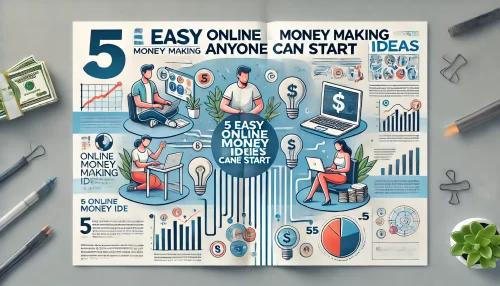Table of Contents
If you’ve been wondering how to make money work for you instead of always working for it, you’re not alone.
In 2025, the rules of building wealth are shifting, and the smartest strategies are no longer about grinding harder but about putting your money to work in smarter ways.
How can you turn your income into a system that grows even when you’re not actively working?
That’s exactly what we’ll explore in this guide, with practical strategies you can start using today.
Build Passive Income Streams That Grow Over Time
If you really want to make money work for you, you need to shift your mindset from trading hours for dollars into building systems that generate income on their own.
Passive income isn’t about getting rich overnight—it’s about creating assets that keep paying you long after the initial effort.
Invest in Dividend-Paying Stocks for Steady Cash Flow
Dividend stocks are one of the simplest ways to start. These are shares of companies that pay you a portion of their profits on a regular basis—usually every quarter.
Think of it like owning a tiny slice of a business that sends you “thank you” checks for being an investor.
Here’s how I approach it:
- Look for companies with a history of increasing dividends (often called “Dividend Aristocrats”).
- Reinvest dividends automatically so your money compounds over time. Most brokerages let you toggle this with a simple setting in your dashboard.
- Don’t chase only high-yield stocks; focus on companies that are financially stable.
Example: If you own 100 shares of a company paying $2 per share annually, you’re pocketing $200 in dividends every year without lifting a finger. Scale that up across multiple companies, and you’ve got a reliable income stream.
Use Affiliate Marketing to Earn While You Sleep
Affiliate marketing is one of my favorite digital-age money machines. You recommend a product, someone buys through your link, and you get a commission.
The beauty is, you don’t need to create or ship anything—just connect people with solutions they’re already looking for.
Practical tips:
- Start with products you actually use and trust—it makes your recommendations more authentic.
- Build a blog, YouTube channel, or even an email list around a niche. For instance, a fitness blogger can promote workout gear or supplements.
- Use platforms like Awin or specialized affiliate programs (think software companies or course creators) for higher payouts.
If you set up a single blog post that ranks on Google, it can bring in affiliate commissions for years with minimal updates. That’s your content working 24/7 while you sleep.
Create and Sell Digital Products That Scale
Digital products are powerful because they take effort once but sell infinitely without inventory costs. Examples include ebooks, templates, courses, or even design assets.
Why this works so well:
- Costs are low—you build once and sell forever.
- Delivery is automated. Once someone purchases, they get instant access.
- Scalability is unlimited—you can sell 10 or 10,000 copies without additional effort.
Pro tip: Bundle your digital products. For example, instead of just selling a budgeting spreadsheet, package it with a short video tutorial and a guide. This makes your offer more valuable and lets you charge a higher price.
Automate Rental Income With Property Management Tools
Rental properties have always been a solid way to make money work for you, but managing tenants and maintenance can eat up your time. That’s where automation comes in.
Tools like Buildium or AppFolio let you:
- Collect rent online automatically.
- Track expenses and property performance in real time.
- Handle tenant communication without juggling phone calls and texts.
You can even hire property management companies that take a percentage of rent in exchange for handling everything. This transforms real estate into a nearly hands-off source of monthly income.
Maximize Your Earnings Through Smart Investing
Once you’ve built passive income streams, the next step is to make your money multiply. Smart investing is how you move from simply saving to growing wealth.
It’s not about timing the market—it’s about consistent, educated choices that balance growth and security.
Diversify Your Portfolio With ETFs and Index Funds
If picking individual stocks feels overwhelming, ETFs (Exchange-Traded Funds) and index funds are your best friends. They let you invest in a basket of companies at once, reducing risk.
Why I recommend them:
- They’re cost-effective with low management fees.
- You instantly diversify across sectors and industries.
- Many brokerages allow you to set up recurring investments automatically.
For example, an S&P 500 index fund gives you exposure to 500 of the largest U.S. companies in one move. Historically, these funds have averaged around 7–10% annual returns.
Explore Real Estate Crowdfunding for Accessible Property Gains
Buying property outright can feel out of reach, but real estate crowdfunding platforms open the door for smaller investors. With as little as $500, you can pool money with others to invest in residential or commercial projects.
What I like about this approach:
- Lower entry cost compared to buying a whole property.
- Diversification—you can invest in multiple projects instead of one.
- Platforms provide transparency with dashboards showing project timelines, expected returns, and payouts.
It’s a way to get exposure to real estate without becoming a full-time landlord.
Take Advantage of Fractional Investing Platforms
Fractional investing lets you buy pieces of expensive assets—stocks, real estate, even art. Instead of needing $3,000 for a full share of a company like Amazon, you can invest $30 and still own a fraction.
How this helps you:
- Makes high-value investments accessible.
- Allows you to diversify more easily with smaller amounts.
- Great for beginners who want to test the waters.
Apps like Robinhood, Public, or Fundrise make the process simple and mobile-friendly. With a few taps, you can build a balanced portfolio without needing thousands upfront.
Balance Risk and Reward With Bonds and Alternative Assets
Not every dollar should chase aggressive growth. Bonds, REITs (Real Estate Investment Trusts), and even alternative assets like gold or crypto can balance your portfolio.
Here’s my rule of thumb:
- Younger investors can lean heavier on stocks for growth.
- As you get closer to retirement, shift more into bonds and stable assets.
- Sprinkle in alternatives carefully—they can hedge against inflation and market dips.
The point is to create a portfolio that can weather storms while still growing steadily. That’s what makes your money work for you long term.
Use Technology to Multiply Your Income Potential
Technology has made it easier than ever to make money work for you, even if you’re starting small.
Instead of trading time for every dollar, you can set up tools and systems that keep running in the background.
Leverage AI Tools to Automate Side Hustles
AI isn’t just a buzzword anymore—it’s a real way to free up your time while boosting earnings. Imagine automating tasks you’d normally pay someone for, like customer support, marketing, or even content creation.
Practical examples:
- If you run a blog, tools like Jasper or Copy.ai can generate first drafts of articles, freeing you to polish instead of write from scratch.
- For email marketing, platforms like Aweber can segment subscribers automatically. From the dashboard, click “Automations > Create New” to set up sequences that nurture leads while you sleep.
- Chatbots like ManyChat handle customer questions on Facebook or Instagram, which means you don’t have to answer DMs at midnight.
The trick isn’t to let AI replace your effort but to let it amplify what you’re already doing. Used smartly, it becomes like a digital employee that costs almost nothing.
Sell on Ecommerce Platforms With Dropshipping
Dropshipping is one of the simplest ways to step into ecommerce without stocking inventory. You list products online, customers order, and the supplier ships directly to them. You never touch the product.
Here’s how to set it up:
- Choose a platform like Shopify.
- Connect a supplier through apps like Spocket.
- From your store dashboard, click “Products > Import” to instantly add items to your storefront.
Real-world scenario: Let’s say you sell trending phone cases. You list them for $20, your supplier charges you $7, and you pocket the $13 difference. Multiply that across dozens of products, and you’ve got a scalable business.
It’s competitive, so I suggest focusing on a niche—like eco-friendly products or pet accessories—to stand out.
Build Online Courses With Low Overhead Costs
If you’ve ever taught a friend how to use Excel formulas, bake bread, or edit videos, you already have the raw material for an online course.
Platforms like Teachable or Thinkific make it ridiculously simple to package your knowledge.
What makes this powerful:
- You record lessons once, but they sell repeatedly.
- Course platforms handle payments, hosting, and delivery automatically.
- You can start small. Even a mini-course priced at $27 can bring consistent income.
For example, inside Teachable’s dashboard, you’d click “Courses > New Course” and upload videos directly. Add quizzes, downloadable PDFs, and a private community group to increase value.
Courses aren’t about being the “ultimate expert.” They’re about helping people who are just a few steps behind you.
Grow Through Subscription-Based Models and Memberships
Subscriptions turn unpredictable income into predictable monthly revenue. Think of it as building your own Netflix, but around your niche.
Ideas that work:
- A fitness coach offering a $15/month workout library.
- A freelancer sharing exclusive job leads in a $10/month membership group.
- A creator delivering new stock photos or templates every month.
Platforms like Patreon, Kajabi, or Memberful make setup easy. From your dashboard, you can set tiers (e.g., $5 for basic access, $20 for premium content) and automate recurring billing.
The beauty of subscriptions is the compounding effect. Add just 10 new members per month, and within a year, you’ve built a base of 120 paying subscribers generating consistent income.
Turn Your Skills Into Profitable Assets
Your skills are more valuable than you think. The right approach can turn what you already know into a source of income that grows with time.
Instead of waiting for opportunities, you create them.
Freelance Your Expertise on High-Demand Platforms
Freelancing is the fastest way to turn your skills into cash. Platforms like Upwork, Fiverr, and Toptal connect you directly with clients who need work done.
Here’s what I suggest:
- Start by niching down. Instead of being a “writer,” market yourself as a “tech blog writer” or “email sequence copywriter.”
- Use client-friendly profiles. Upload samples, describe specific results you’ve delivered, and set clear rates.
- From Upwork’s dashboard, you can filter jobs under “Find Work > My Categories” to target your niche.
If you treat freelancing like a business instead of a side gig, you’ll land better-paying clients and create recurring contracts instead of one-offs.
Package Your Knowledge Into Coaching or Consulting
Consulting is essentially freelancing for your brain. Instead of doing the work, you guide others through it.
For example, if you’ve grown an Instagram account to 50k followers, there are small businesses that will happily pay for your blueprint.
Coaching platforms like Clarity.fm even let you set a per-minute rate for calls.
I suggest starting simple:
- Offer 1:1 Zoom sessions.
- Record reusable materials like workbooks or frameworks to make sessions more efficient.
- Upsell group coaching when you’re comfortable—this lets you scale without adding more hours.
You don’t need decades of experience. You just need to be one step ahead of the person you’re teaching.
License Creative Work for Royalties
If you’re creative—whether that’s photography, writing, design, or music—you can license your work for ongoing royalties. That means you create once and get paid every time someone uses it.
Examples:
- Upload photos to Shutterstock or Adobe Stock. Every download earns you a royalty.
- Musicians can upload tracks to sites like Epidemic Sound, where creators license them for YouTube videos.
- Writers can license templates, scripts, or worksheets on marketplaces like Etsy or Creative Market.
I know a designer who created just 10 Canva templates, uploaded them on Etsy, and now makes $500–$800 a month passively. That’s a smart way to let your creativity keep working for you.
Use Social Media to Attract Paying Clients
Social media isn’t just for memes and scrolling—it’s a client magnet if you use it with intention. Platforms like LinkedIn, Instagram, and TikTok can showcase your expertise for free.
Here’s how to turn it into a client funnel:
- Post value-driven content (tips, tutorials, case studies).
- Add clear calls-to-action like “DM me if you want this done for your business.”
- Nurture conversations in DMs instead of spamming sales pitches.
Example: A web designer who posts quick “before and after” website makeovers on TikTok can attract business owners who think, “I need that.” That’s organic marketing that costs nothing but pays well.
Pro Tip: Stack These Strategies Together
You don’t need to pick just one. A freelancer can use social media to attract clients, package their knowledge into a course, and then add a subscription model for ongoing value.
That’s when you really make money work for you—because your income grows in layers instead of one fragile stream.
Optimize Your Money With Smart Financial Habits
Smart financial habits aren’t about living like a monk or denying yourself coffee. They’re about creating systems that let your money do the heavy lifting so you don’t have to think about it every day.
Automate Savings and Investments to Stay Consistent
Consistency beats intensity when it comes to building wealth. Automation removes the mental friction of “Should I save this month or not?”
Here’s what works:
- In your bank’s dashboard, set up automatic transfers to your savings account on payday. Even $100 each paycheck compounds fast.
- Inside platforms like Vanguard or Fidelity, click “Automatic Investments” to schedule recurring contributions to an index fund.
- Use apps like Acorns or Stash, which round up your daily purchases and invest the spare change without you noticing.
When money leaves your checking account before you see it, you’ll adapt to what’s left. It feels almost invisible, but years down the line, that invisible growth becomes your freedom fund.
Cut Recurring Expenses Without Sacrificing Quality of Life
I once realized I was paying for three streaming services but only watching one. That’s $30+ every month wasted—nearly $400 a year.
Tips to trim fat without losing joy:
- Open your credit card or bank statement and highlight every subscription.
- Use services like Truebill (now Rocket Money) that flag recurring charges and let you cancel them in one tap.
- Negotiate bills—many phone or internet providers will lower rates if you ask.
Cutting expenses isn’t about deprivation—it’s about redirecting money from stuff you don’t use toward things that actually build your future.
Use High-Yield Savings Accounts for Emergency Funds
Your emergency fund shouldn’t just sit in a low-interest account. High-yield savings accounts (HYSAs) offer rates 10x higher than traditional banks.
For example: If you have $10,000 in a HYSA earning 4%, that’s $400 a year just for parking your money safely. Compare that to $10 in a typical savings account at 0.1%.
Steps:
- Open an HYSA with a reputable online bank.
- Link it to your main checking account for easy transfers.
- Keep at least 3–6 months of living expenses there for peace of mind.
You’ll still have access when needed, but your money won’t sit idle.
Track Cash Flow With Budgeting Apps and AI Finance Tools
It’s hard to make money work for you if you don’t know where it’s going. Budgeting apps turn financial fog into a clear dashboard.
- Mint connects to your bank and shows real-time spending across categories.
- YNAB (You Need A Budget) forces you to “give every dollar a job,” which is great if you tend to overspend.
- AI tools like Cleo even coach you—asking questions like “Are you sure you want that Uber Eats order?” before you confirm.
I suggest reviewing your cash flow once a week. In Mint, just tap “Trends > Spending by Category” to spot where you’re bleeding money. Once you see it, you can fix it.
Make Tax Strategies Work in Your Favor
Taxes feel intimidating, but they’re actually one of the biggest levers to keep more of what you earn.
The goal isn’t to dodge taxes—it’s to play by the rules while keeping as much of your hard-earned money as possible.
Take Advantage of Retirement Accounts for Tax Benefits
Retirement accounts like 401(k)s or IRAs aren’t just for your future—they save you money today.
- Contributions to traditional accounts reduce your taxable income this year.
- Roth IRAs don’t give upfront breaks, but withdrawals are tax-free later.
Example: If you earn $70,000 and contribute $6,000 to a 401(k), you’re only taxed as if you earned $64,000. That’s hundreds saved immediately.
Check your HR portal—usually under “Benefits > Retirement Plans”—to set up automatic payroll contributions.
Deduct Business Expenses Legally to Reduce Liability
If you freelance, run a side hustle, or own a small business, deductions are your best friend.
You can write off:
- Home office expenses (if used exclusively for work).
- Software tools like Canva, Zoom, or QuickBooks.
- Travel and meals tied directly to client meetings.
Keep receipts organized with apps like Expensify. Snap a photo, and it logs everything into categories ready for tax season.
Use Tax-Loss Harvesting to Offset Investment Gains
If you’ve ever sold stocks at a gain, you know Uncle Sam wants a cut. Tax-loss harvesting helps balance that by selling underperforming investments to offset those gains.
Platforms like Wealthfront even automate this. From your dashboard, you’ll see “Tax-Loss Harvesting” toggled on—it runs quietly in the background.
It’s not about losing money on purpose. It’s about using strategic losses to reduce your taxable gains.
Work With a Tax Professional to Maximize Returns
I believe a good accountant pays for themselves. Beyond filing forms, they find credits and deductions you’d never notice.
Instead of dreading tax season, think of it as a check-in with a financial coach. They’ll help you structure your business, time your investments, and optimize your returns year after year.
Build Wealth With Scalable Online Businesses
Scalable online businesses are where you can truly make money work for you.
Unlike freelancing, where income is tied to hours, these models let you grow without constantly trading time for money.
Start a Blog That Generates Long-Term Ad Revenue
Blogging may sound old school, but it’s still powerful when done right.
Steps to get started:
- Buy a domain on Namecheap.
- Set up hosting on Hostinger or Hostgator.
- Install WordPress and publish your first article.
Monetization comes from ads, affiliate links, and even your own products. The magic? One blog post can rank on Google and earn ad revenue for years.
I suggest aiming for topics with evergreen demand like personal finance, fitness, or tech tutorials.
Monetize Podcasts Through Sponsorships and Partnerships
Podcasting lets you build authority and connect with an audience in a personal way.
Income streams include:
- Sponsorships (companies pay per episode mention).
- Affiliate links in show notes.
- Paid subscriber-only content via Patreon.
A small podcast with just 1,000 loyal listeners can bring in steady sponsorships.
From hosting dashboards like Buzzsprout, you can access “Monetization > Sponsorship Marketplace” to connect with brands directly.
Sell Print-on-Demand Products Without Inventory Costs
Print-on-demand (POD) lets you design products—shirts, mugs, posters—that only get made when someone buys. No boxes in your garage.
Platforms like Printful connect directly with Shopify or Etsy. From your store’s dashboard, just click “Add Product > Choose Design” and upload your artwork.
Margins are smaller per item, but the scalability is huge. I know creators who started with one t-shirt design and now have entire POD brands earning six figures.
Grow a YouTube Channel Into a Passive Income Machine
YouTube is both a search engine and a revenue engine. Videos you post today can earn you money for years.
Ways to monetize:
- AdSense revenue once you hit 1,000 subscribers and 4,000 watch hours.
- Affiliate links in video descriptions.
- Sponsored collaborations.
Pro tip: Use TubeBuddy’s keyword explorer inside your dashboard to find topics with low competition and decent search volume. That’s how you grow faster.
You don’t need Hollywood-level production. A simple camera, good audio, and clear teaching style can build an audience that pays you back for years.
Protect and Multiply Wealth Through Smart Planning
It’s not enough to make money work for you—you also need to protect it. Smart planning ensures your wealth survives setbacks and grows stronger over time.
Build an Emergency Fund That Covers at Least 6 Months
An emergency fund is your financial seatbelt. Life throws curveballs—job loss, medical bills, or sudden repairs—and without a cushion, you risk debt.
- Aim for at least 3–6 months of expenses. If your monthly costs are $3,000, that’s $9,000–$18,000.
- Keep this fund in a high-yield savings account so it’s liquid but still earning interest.
- Automate transfers—log into your bank dashboard, click “Transfers > Recurring” and set a fixed amount weekly or monthly.
From experience, having a six-month cushion feels like breathing room. Emergencies stop being financial earthquakes and become manageable bumps.
Invest in Insurance to Safeguard Your Assets
Insurance may not feel exciting, but it’s one of the smartest ways to shield wealth. Without it, a single accident could wipe out years of progress.
Essential coverage includes:
- Health insurance to protect against medical debt.
- Life insurance if you have dependents who rely on your income.
- Disability insurance in case you’re unable to work.
- Property insurance for your home or rental investments.
Think of it as paying a small fee to transfer your biggest risks onto someone else’s shoulders. That’s how you keep your money working for you even in worst-case scenarios.
Create an Estate Plan to Secure Your Legacy
An estate plan isn’t just for millionaires—it’s for anyone who wants control over what happens to their assets. Without one, the state decides.
Steps to start:
- Write a will outlining who inherits your assets.
- Consider a trust for more complex estates or tax advantages.
- Name beneficiaries for retirement accounts and insurance.
- Assign power of attorney and healthcare directives.
Even simple planning prevents legal battles and ensures your wealth benefits the people you care about. I suggest setting a calendar reminder to review your plan every 2–3 years.
Reinvest Profits to Compound Long-Term Growth
The difference between “making money” and “building wealth” is reinvestment. Instead of cashing out every gain, put profits back to work.
- If you own dividend stocks, turn on dividend reinvestment (often called DRIP) inside your brokerage dashboard.
- Business owners can reinvest into marketing, new products, or automation tools to fuel growth.
- Real estate investors can roll profits into new properties through a 1031 exchange.
Albert Einstein called compounding the “eighth wonder of the world” for a reason. Small reinvestments now snowball into massive growth over decades.
Learn How to Make Money Work for You Through Education
Knowledge compounds like money. Staying curious and updated makes sure your strategies don’t get outdated in a fast-changing financial world.
Stay Ahead With Online Courses and Skill Platforms
The internet has leveled the playing field. Platforms like Coursera, Skillshare, and Udemy give you access to skills that used to require expensive degrees.
For example, a quick course on “Digital Marketing Analytics” can teach you how to track ROI from ads. From Coursera’s dashboard, you’d click “My Courses > Enroll” and instantly dive in.
I recommend treating education like an investment—dedicate a small monthly budget for courses that strengthen your earning potential.
Read Wealth-Building Books That Teach Modern Strategies
Books are like mentors you can buy for $20. And unlike social media soundbites, they offer depth.
Examples worth picking up:
- Books on behavioral finance to understand money psychology.
- Modern investment guides that explain index funds, crypto, or real estate.
- Biographies of entrepreneurs who’ve built wealth in creative ways.
Even 20 minutes of reading daily can shift how you think about money, which directly changes how you use it.
Follow Finance Blogs and Podcasts for Fresh Insights
Blogs and podcasts give you real-time updates that books can’t. Markets change, tax laws shift, and new income opportunities emerge constantly.
I advise creating a “learning habit” by following 2–3 trusted sources and listening during your commute or workouts. Over time, you’ll absorb strategies that help you pivot quickly.
Join Mastermind Groups and Networking Communities
There’s power in surrounding yourself with people on the same journey. Mastermind groups, forums, or even private Discord communities can open doors.
Benefits include:
- Accountability—you stick to your financial goals because others are watching.
- New ideas from people already achieving what you want.
- Potential collaborations on side hustles or investments.
I once joined a small mastermind group for content creators, and within six months, I learned hacks for doubling affiliate revenue that I’d never have found on my own.
Adopt a Long-Term Mindset for Lasting Financial Freedom
Wealth isn’t a sprint—it’s a marathon. A long-term mindset keeps you grounded when markets dip and focused when shiny distractions pop up.
Focus on Compound Growth Instead of Quick Wins
It’s tempting to chase the next big trend, but most overnight riches fizzle. Compound growth—steady, incremental increases—is what builds lasting wealth.
Instead of asking, “How can I double my money fast?” ask, “How can I grow 7–10% year after year?” That shift in perspective protects you from risky bets.
Create Systems Instead of Relying on Motivation
Motivation fades. Systems stick. Automating savings, scheduling recurring investments, or blocking weekly money check-ins ensures progress even when you’re tired or busy.
For example, in budgeting apps like YNAB, you can set “Rule Four: Age Your Money,” which forces you to live on last month’s income. It’s a system that naturally builds financial stability.
Set Financial Goals With Clear Timelines
Goals without deadlines are just wishes. Set specific targets:
- “I want $10,000 in my emergency fund within 18 months.”
- “I’ll invest $500/month into index funds for the next 10 years.”
Use trackers—whether spreadsheets or apps—to measure progress. Seeing milestones tick upward keeps you motivated.
Review and Adjust Strategies as Markets Change
What worked five years ago may not work today. Reviewing your finances quarterly helps you adapt.
I suggest a simple process:
- Check portfolio performance.
- Compare spending habits against goals.
- Rebalance investments if one area grew too heavy.
This ensures your money keeps working for you, even when the economy shifts.
Expert Tip to Apply Right Away
Don’t wait for the “perfect plan.” Start small—automate $50 into savings, read one chapter of a finance book, or draft your first blog post.
Action creates momentum, and momentum compounds into freedom.
The earlier you start, the sooner your money stops being a burden and starts being your partner.






